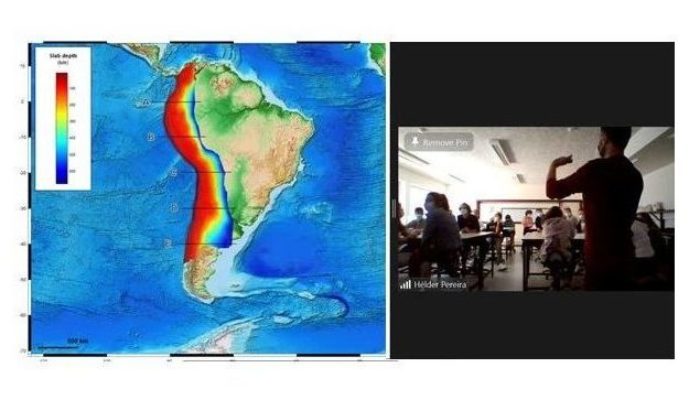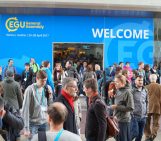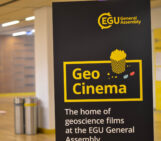
For the vEGU21 General Assembly, the EGU Education & Outreach Committees tried something new. They connected school teacher, Hélder Pereira, with seismologist, Susana Custódio, to create and teach a lesson plan on a topic relevant to Hélder’s classroom curriculum: the origin of the South American volcanic gaps. The lesson was live streamed online from Hélder’s class in Algarve, Portugal, with Scientist, Susana, joining virtually from the University of Lisbon. In addition to Hélder’s curious students, over 40 equally intrigued EGU conference participants joined his class to get a taste of the EGU’s Teacher-Scientist Pairing Scheme.
“It is always a great experience to be able to bring hands-on science into school classrooms. This format [paired teaching] allowed us to do this even though we could not be in the classroom in person,” said Susana, the guest scientist. This experience was also well-received by Hélder’s classroom students. “They felt like real scientists, using different types of data to explore an unanswered question. They learned how science really works,” Hélder reported after hearing about his students’ experience in a post-session meeting.
The recording and the lesson plan for this vEGU21’s session are available at:
- Watch the recording of the live session (mostly in Portuguese with introduction and post-session discussions in English)
- Download lesson plan and supporting documents
What is unique about paired teaching?
The EGU Teacher-Scientist Pairing Scheme uses a teaching pedagogy known as Paired Teaching. Paired teaching is an innovative technique that brings together school teachers and scientists to collaborate, as equal partners, on developing and teaching lesson plans focused on topics that are relevant to participating teachers and their classrooms. The pedagogy is designed to support the teaching of scientific concepts by the lively video presence of a “guest scientist” and hands-on activities that are carried out in the classroom under the guidance of the “in-class teacher”. The image below shows how this was done collaboratively by Susana (guest scientist) and Hélder (in-class teacher) at the vEGU21.

Paired teaching roadmap for the vEGU21 Teacher-Scientist pairing scheme. The guest scientist teaches the lesson plan in short video segments (yellow boxes on the left) with the in-class teacher facilitating the classroom activities and discussions in between video segments (white boxes on the right). This passing of teaching between the scientist and the teacher is a type of blended learning known as paired teaching.
Examples of paired teaching video lessons
There are several educational resources for school teachers that incorporate the paired teaching technique, including the video library of MIT BLOSSOMS which contains over 100 STEM lessons, all freely available to teachers as streaming video and internet downloads. For videos on geosciences topics, the ParsQuake Project has developed and released a series of video lessons that cover topics ranging from plate tectonics and faulting to earthquake hazards and mitigation techniques. Recently, this technique was tested by Mohadjer et al. (2021) with school students (12-14 years of age) in Tajikistan and the UK to assess its effectiveness in communicating Earth sciences concepts such as Earth’s interior, plate motions, and earthquake hazards.
Future paired teaching activities at EGU
Based on the successful implementation of this year’s pairing scheme, the EGU’s Outreach Committee plans to scale-up this initiative in the coming years by bringing teachers and scientists together to create free video lessons that incorporate the paired teaching technique. Scientists and school teachers who are interested in learning more about this initiative and/or participating in our next pairing scheme, please get in touch with the Outreach Committee at outreach@egu.eu




